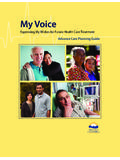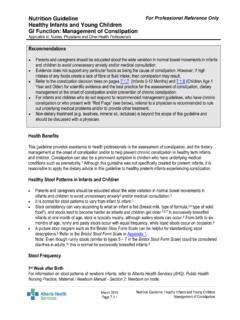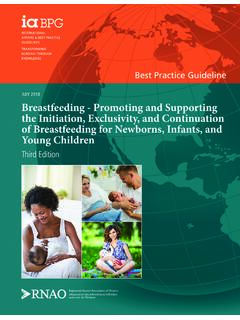Transcription of Pediatric Nutrition Guidelines - Ministry of Health
1 Pediatric Nutrition Guidelines (Six Months to Six Years). FOR Health PROFESSIONALS. NOVEMBER 2016. Background and Acknowledgements Background Acknowledgements This document outlines evidence-informed Nutrition and feeding Guidelines and Provincial Health Services Authority (PHSA) would like to thank the more Nutrition risk indicators for healthy , full-term infants and children from about six than forty dietitians, nurses, dental hygenists, pediatricians, and other months (introducing solid foods) up to six years of age. Its purpose is to assist Health Health professionals from throughout the province who reviewed the professionals in British Columbia to provide high-quality care by identifying: Guidelines and provided feedback. A special thanks to the Provincial Food and Nutrition Resource Stakeholder Advisory Group who provided their infants and children who are achieving developmental milestones that relate to feeding Nutrition expertise and helped coordinate the review process in First infants and children who are being fed in a manner that meets their Nutrition needs Nations Health Authority, Fraser Health Authority, Interior Health markers of increased nutritional risk Authority, Island Health Authority, Northern Health Authority, and Vancouver Coastal Health Authority.
2 Also, a special thank you to This document is intended to be a quick reference guide. Relevant resources are provided Dietitian Services at HealthLink BC, BC Ministry of Health , Child Health within the document for reference to more detailed information and related services. BC, Perinatal Services BC, BC Pediatric Society, Doctors of BC, BC. Children's Hospital, and the healthy Start Working Group who The Provincial Health Services Authority (PHSA) developed this document in 2016 to provide contributed to reviewing the Guidelines . guidance for all Health professionals who work with infants and children in British Columbia. It is based on Ontario's Pediatric Nutrition Guidelines (Birth to Six Years) for Health Project Advisory Committee Professionals and has been adapted and reproduced with permission from the Ontario Lori Smart, MHA, RD.
3 Society of Nutrition Professionals in Public Health .* Manager, Resource Coordination, Dietitian Services, HealthLink BC. Cynthia Watt, MBA, RD. Provincial Manager, healthy Eating Resource Coordination, Population and Public Health , BC Centre for Disease Control, PHSA. Margaret Yandel, BHE, RD. Manager, Nutrition Policy and Promotion, Population and Public Health , BC Ministry of Health Kristen Yarker, MSc, RD. Project Consultant * Adapted and reproduced with permission from the Ontario Society of Nutrition Professionals in Public Health Pediatric Nutrition Guidelines (Six Months to Six Years) for Health Professionals November 2016 2. Table of Contents 6-9 Months 4. 4. Nutrition Risk 5. 9-12 Months 6. 6. Nutrition Risk 7. 12-24 Months 8. 8. Nutrition Risk 9. 2-6 Years Nutrition Risk Additional Information Parent/Caregiver Influences on Eating Growth Informed Decision Making About infant Commercial infant Food Allergy Choking Fish Consumption and Nutrition Resources Pediatric Nutrition Guidelines (Six Months to Six Years) for Health Professionals November 2016 3.
4 6-9 months MILESTONES Guidelines . A marker of a point in development related to Guidelines are evidence-informed recommendations for Nutrition and feeding . Signs of developmental readiness for solid foods Fluids Food may appear a few weeks before or just after 6 Advise to continue to breastfeed. Promote Advise to avoid delaying the introduction of solid foods beyond months of age: the importance of breastfeeding beyond about 6 months of age to reduce the risk of iron Has better head 6 months while supporting the mother Solid foods can be offered before or after breast milk. The Can sit up and lean regarding her order may change depending on what works best for the Signals caregiver when they are full If a decision is made to use commercial parent/caregiver and ( turns head away).2 infant formula, ensure that the parent/ Advise that soft textures and finger foods can be introduced Can pick up food and try to put it in caregiver has all the information needed, starting at about 6 months of For more information on their and support and educate as required, see safe textures and finger foods see Additional Information.
5 Has vertical jaw movement (munching).3 Additional Information Informed Choking Prevention on page 15. Has some tongue protrusion when beginning Decision Making About infant feeding on Emphasize that it is important to quickly progress to include to eat solid foods which decreases with page 13 and Commercial infant Formula lumpy textures so that by 12 months of age the infant is eating on page 14. modified family May still have early gag reflex until around Recommend that all infants who are Recommend that iron-rich foods be offered first and offered 7 breastfed or fed some breast milk be 2 or more times each See Additional Information Iron Often rejects unfamiliar foods a number given a liquid vitamin D supplement of on page 15. of 400 IU (10 g) every Advise to introduce a variety of vegetables, fruit, grains and Advise that small amounts of water can dairy products (except cow milk or goat milk as a beverage) in See Additional Information Parent/Caregiver be offered from an open any sequence after iron-rich Influences on Eating Habits on page 12.
6 Advise the delay of cow milk (vitamin D Advise that there is no need to introduce new foods one-at- fortified goat milk) until 9 - 12 months a-time, except for the common food allergens [cow milk, egg, due to its low iron content and risk of peanut, tree nuts, soy, seafood (fish, shellfish, crustaceans), iron deficiency with early wheat and sesame]. These should be introduced one-at-a-time. If juice is given, recommend no more Advise that the introduction of common food allergens should than 125 mL ( cup) of 100% juice a not be These foods can be introduced when the day and only as a part of a meal or snack. infant is ready for other solid , 7, 8 See Additional Information Recommend juice be offered from an Food Allergy Prevention on page 14. open cup, not a bottle or sippy Advise offering an amount of food based on the principles of Encourage consumption of whole the Division of Responsibility.
7 See Additional Information . vegetables and fruit instead of juice. Parent/Caregiver Influences on Eating Habits on page 12. * Adapted and reproduced with permission from the Ontario Society of Nutrition Professionals in Public Health Pediatric Nutrition Guidelines (Six Months to Six Years) for Health Professionals November 2016 4. 6-9 months Guidelines (continued) Nutrition RISK INDICATORS. May require additional action, investigation and/or referral. Nutrition risk indicators represent a variety of levels of risk including poor nutritional status, increased nutritional risk, and Food (continued) identification of the opportunity for early detection and intervention before nutritional problems manifest. Nutrition risk Advise to provide a routine of 3 - 5 solid food indicators do not represent a validated Nutrition screening tool, a Nutrition assessment, nor diagnostic criteria.
8 Feedings per day and include infants in family The presence of Nutrition risk indicators requires various actions such as further investigation by the Health professional, meals whenever possible, even if their feeding intervention in the form of parents/caregiver counseling, and referral. Referral to a registered dietitian (RD) for Nutrition times do not See Additional Information assessment and ongoing follow-up may be warranted for infants and children who do not meet Guidelines or who Parent/ Caregiver Influences present with Nutrition risk indicators. Contact 8-1-1 Dietitian Services at HealthLink BC for more information. on Eating Habits on page 12. Recommend limiting fish higher in mercury. To prevent food-borne illness, advise to avoid: Honey, including pasteurized or cooked, Growth concerns.
9 See Additional Information Parent/caregiver expresses concern/anxiety Growth Monitoring on page 13. about feeding or infant 's weight, including current until 1 year of age Raw or undercooked eggs or products Does not consume iron-rich foods daily5 or is at weight or risk of overweight in the 16. increased risk for iron deficiency. See Additional Information Parent/ Caregiver containing raw/undercooked eggs11. See Additional Information Iron on page 15. Influences on Eating Habits on page 12. Raw or undercooked fish and shellfish11. Raw or undercooked meat, deli meats Is offered foods that are choking hazards. See Food selection is restricted due to food insecurity, Additional Information Choking Prevention cultural or lifestyle reasons ( vegan) or food and hotdogs11. on page 15. allergy/intolerance.
10 Raw or lightly cooked sprouts11. Unpasteurized cow/ goat milk and milk Consumes cow or goat milk, plant-based milk Constipation. For more information see, alternatives ( soy, rice, almond beverage), Constipation, Age 11 and Younger and healthy products (including raw cheeses)11. homemade infant Bowel Habits. Unpasteurized fruit and vegetable juice unless produce is washed and freshly Consumes fruit drinks/ punch, sports drinks, pop infant has severe atopic dermatitis (eczema), or beverages containing artificial sweeteners which could indicate an increased risk of squeezed immediately before or developing a food allergy. See Additional consumption11. Consumes more than 125 mL ( cup) juice Information Food Allergy Prevention on page 14. per day. Not supervised during feeding , including having a bottle in feeding schedules or expectations that repeatedly frustrate the infant .














